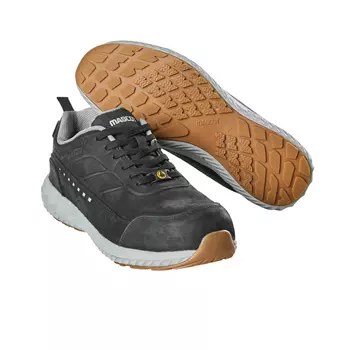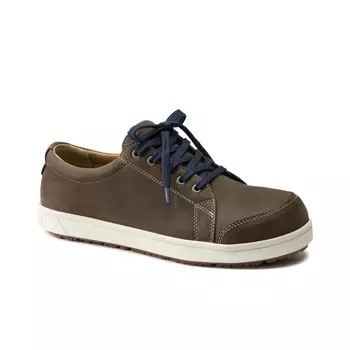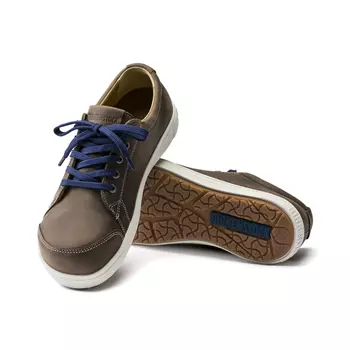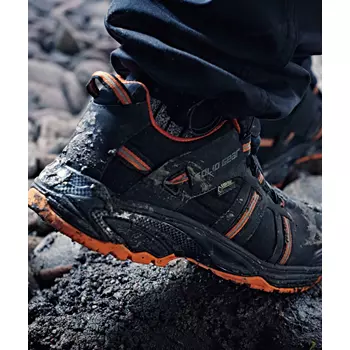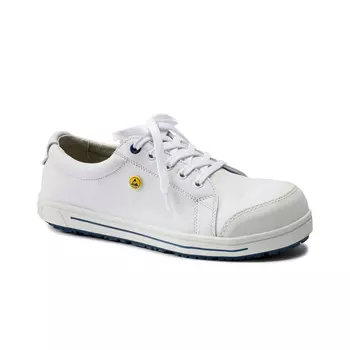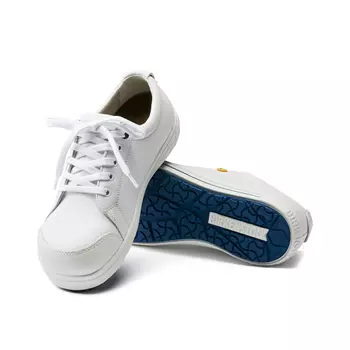Guide to safety footwear
When choosing safety shoes or safety boots for work, there are many factors to consider. Are you aware of the safety requirements for footwear in your workplace? Below, you can learn more about what the different safety classes mean.
Certified safety shoes
Safety footwear is certified according to the European standard EN ISO 20345. All footwear with this certification has toe caps that, at a minimum, protect against falling objects with 200 joules (J) of impact and compression up to 15 kilonewtons (kN). This basic standard is called SB.
All safety shoes are tested in the same way, regulated by the European Union. When the test is completed, the footwear is CE-marked, ensuring compliance with European legislation. All safety footwear at Pro-dress is, of course, CE-approved.
Safety shoes with toe caps
Toe caps protect your feet from being crushed if hit by something heavy. Below are the different types of toe caps:
- Toe caps made of steel are strong and thin, taking up little space in the safety footwear. However, they might feel cold when used in low temperatures and are heavier than other options.
- Toe caps made of aluminum have similar properties to steel but are 50% lighter.
- Toe caps made of fiberglass or composite are 100% metal-free and provide better insulation against cold and heat. Fiber and composite are often used in lightweight safety shoes, as these materials are lighter than both steel and aluminum but offer similar protection.
Safety shoes with penetration protection
Penetration-resistant inserts prevent sharp or pointed objects from piercing the soles and injuring your feet. Here are the different types of penetration protection:
- Steel midsoles are strong and suitable for places with a risk of stepping on small sharp objects
- Fibre midsoles are flexible, metal-free, and do not conduct cold
- Midsoles made of wood are primarily used in clogs. They provide insulation against cold and are suitable for static work
Slip-resistant safety shoes
If you work in environments with slippery floors, you should choose safety shoes with slip-resistant properties. This could be a floor in an industrial kitchen where oil, water, or other substances are sometimes spilled. Slip-resistant safety footwear can be labeled with the following three abbreviations:
ESD safety shoes
All approved safety shoes have antistatic properties. ESD (electrostatic discharge) ensures that the shoes are extra antistatic by continuously discharging static electricity through the sole in a controlled manner. ESD-approved safety footwear helps prevent damage to electronics or other sensitive equipment in the workplace.
Note that shoes are approved as a whole. This means that the shoes are no longer ESD-approved if you use different insoles than the original ones. Similarly, thick woolen socks can reduce the shoes' antistatic properties. To get the full benefits of ESD-approved safety shoes, you should use ESD socks.
What do the different safety classes mean?
When shopping for safety shoes or safety boots, you will likely come across classes SB, SBP, S1, S1P, S2, S3, S4, and S5. Here’s a breakdown of what the classifications mean:
| EN ISO 20345:2022 | Safety footwear | Waterproof boots | Safety footwear | ||||||||||||||
| Safety classes | SB | S1 | S1P | S1PL | S1PS | S2 | S3 | S3L | S3S | S4 | S5 | S5L | S5S | S6 | S7 | S7L | S7P |
| SB | √ | √ | √ | √ | √ | √ | √ | √ | √ | √ | √ | √ | √ | √ | √ | √ | √ |
| P | X | X | √ | X | X | X | √ | X | X | X | √ | X | X | X | √ | X | X |
| PL | X | X | X | √ | X | X | X | √ | X | X | X | √ | X | X | X | √ | X |
| PS | X | X | X | X | √ | X | X | X | √ | X | X | X | √ | X | X | X | √ |
| WPA | X | X | X | X | X | √ | √ | √ | √ | - | - | - | - | X | X | X | X |
| WR | X | X | X | X | X | X | X | X | X | - | - | - | - | √ | √ | √ | √ |
| E | X | √ | √ | √ | √ | √ | √ | √ | √ | √ | √ | √ | √ | √ | √ | √ | √ |
| A | X | √ | √ | √ | √ | √ | √ | √ | √ | √ | √ | √ | √ | √ | √ | √ | √ |
| Profiled outsole | X | X | X | X | X | X | √ | √ | √ | X | √ | √ | √ | X | √ | √ | √ |
SB: Toe protection (withstands at least 200 J from falling objects and at least 15 kN from compression)
P: Penetration resistant metal midsole tested with a Ø 4.5 mm nail (resistance to penetration of at least 1100 newtons)*
PL: Penetration resistant non-metal midsole tested with a Ø 4.5 mm nail (resistance to penetration of at least 1100 newtons)*
PS: Penetration resistant non-metal midsole tested with a Ø 3.0 mm nail (resistance to penetration of at least 1100 newtons)*
WPA: Water penetration and absorption (water-repellent upper materials that ensure at least 60 minutes without water penetration)
WR: Water resistant
A: Antistatic properties from 0.1 MΩ to 1000 MΩ
E: Shock absorption in the heel area (at least 20 J)
*A smaller nail diameter = higher pressure on the sole
Requirements for chainsaw boots
When using a chainsaw, you must wear cut-resistant boots certified according to the European standard EN ISO 17249:2013. The safety boots must have non-slip soles, toe caps to protect against falling objects, and cut-resistant inserts to protect the user from cuts and sawing. The steel toe cap must be at least Class S. The cut-resistant insert should at a minimum meet the requirements for Protection Class 2 or 3.
Chainsaw boots are classified based on the chainsaw's chain speed:
| Class 1 | 20 m/s |
| Class 2 | 24 m/s |
| Class 3 | 28 m/s |
Work shoes without safety
When purchasing shoes for work, there are two important EU standards to be aware of: EN ISO 20345 (safety shoes) and EN ISO 20347 (occupational shoes).
The EN ISO 20345 standard applies to safety footwear that must at least have toe caps.
EN ISO 20347 relates to work shoes without toe caps. Footwear with this certification has at least a non-slip sole and is approved for work in areas where there are no mechanical risks (like impact, compression, or similar). This could include shoes for gastronomy and restaurant work, or shoes for care and clinical settings.
The categories in EN ISO 20345 start with 'S' (safety), while those in EN ISO 20347 start with 'O' (occupational). Therefore, when buying occupational footwear, you might come across certifications like OB, O1, O2, O4, and O6.
Do you need help?
If you have questions or are uncertain about anything related to safety footwear regulations and requirements, you are always welcome to contact our customer service.
We will be happy to assist you!

